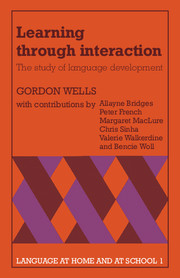Book contents
- Frontmatter
- Contents
- Acknowledgments
- Introduction
- 1 Language as interaction
- 2 Becoming a communicator
- 3 The development of comprehension
- 4 Context, meaning and strategy in parent–child conversation
- 5 Developing linguistic strategies in young school children
- 6 A comparison of talk at home and at school
- 7 Language, literacy and education
- Appendix Bristol language development study: transcripts
- References
- Index
6 - A comparison of talk at home and at school
Published online by Cambridge University Press: 05 June 2012
- Frontmatter
- Contents
- Acknowledgments
- Introduction
- 1 Language as interaction
- 2 Becoming a communicator
- 3 The development of comprehension
- 4 Context, meaning and strategy in parent–child conversation
- 5 Developing linguistic strategies in young school children
- 6 A comparison of talk at home and at school
- 7 Language, literacy and education
- Appendix Bristol language development study: transcripts
- References
- Index
Summary
Introduction
In this chapter we shall bring together the two contexts of home and school and attempt some comparison of the types of interaction that are typical of the two settings. In doing so we shall draw extensively on transcripts of actually occurring interaction, as one of our major aims will be to provide a firm grounding for such a comparison in systematically collected empirical data. Such an empirical basis for comparing the language of home and school is long overdue, particularly since, over the last fifteen years or so, a considerable amount of educational, sociological and political energy has been invested in the study of language in relation to social class and educational disadvantage (see chapter 7 for a discussion of these issues). Yet much of this work has exploited claimed differences between home and school language, without any systematic examination of naturalistic data from either setting. As a result, certain widely held positions have emerged, whose claims to validity are almost impossible to evaluate, but whose sociological and political effects have nevertheless been considerable.
Advocates of these positions can be very broadly (and with over simplification) divided into two groups. Firstly there are those who claim that there is a (usually class-based) difference in the form or use of language in the home, such that for some children there arises a ‘mismatch’ between their prior experience and use of language and the particular linguistic demands of the school, with resultant implications for differential educational success.
- Type
- Chapter
- Information
- Learning through InteractionThe Study of Language Development, pp. 205 - 239Publisher: Cambridge University PressPrint publication year: 1981
- 1
- Cited by

